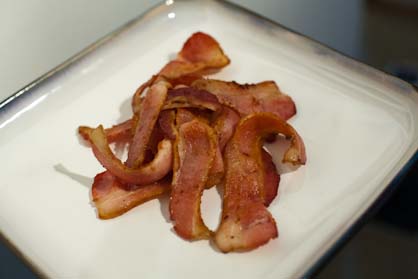
Chef's notes:
While bacon can refer to cured meat of several parts of a pig, in America it most commonly refers to the cured and smoked pork belly. The first step in curing pork is to rub it with lots of salt or soak it in a brine. Color fixatives like sodium nitrite and/or saltpeter are added to keep the meat nice and pink. The bacon is then usually smoked, dried or boiled. Flavors can be added during the brining portion and/or smoking portion. Common smoke flavors are that of different types of wood: applewood and hickory being two popular options.
Bacon can be made from several different cuts of meat. Streaky bacon, pancetta and American bacon come from the pork belly. Middle bacon comes from the side of the pig. Back bacon is made from the loin of the pig. Also called Irish Bacon or Canadian bacon, it is meatier and leaner than other bacon. Cottage bacon is thinly sliced lean pork meat from the shoulder of a pig. Jowl bacon is the cured and smoked cheeks of a pig.
Ingredients
- 1 lb of bacon
Applewood Smoked Medium Thick Cut Bacon Pan-Fried in a Non-Stick Pan over a Medium-High Heat
- The first decision you need to make is what type of bacon you want to cook. As I told you before, there are plenty of options to keep you busy in bacon. For this article, I went with a good mid-level applewood smoked bacon. It had a good balance of meat, fat, sugar and salt.
- Heat up a non-stick skillet on the stove to fry your bacon in. A non-stick skillet is not necessary, since there is little chance that your bacon will stick, but it will make for easier clean-up. Cook your bacon at a medium-high temperature. If your bacon is thin, cook it at medium.
- Once your bacon is cooked on one side, flip it over and continue cooking the other side. The first side should be getting nice and brown and the fat should be rendering. If you are getting too much splatter, drain some of the fat but not all of it. You need some fat to cook the bacon in.
- When your bacon is cooked to your liking, remove it from the pan to a paper towel-lined plate to drip. We all know how we like our bacon. When your bacon gets to that point, remove it from the pan. If you don’t want to put it on paper towels, you don’t have to. I rarely do. But I like the grease on my bacon.
- Fold the paper towel around the bacon to soak up some of the bacon grease. Since bacon is usually a breakfast food, you will want to keep it warm while you cook your eggs or hash or whatever. So just fold it like an envelope and flip it over. The bacon should stay warm long enough for you to cook the rest of breakfast.
Tips & Tricks
- Many things can be made from bacon. Some traditional bacon dishes include BLT’s (bacon, lettuce and tomato sandwiches), bacon and eggs, and Cobb salad. Bacon also works well when wrapped around things like Filet Mignon and Sea Scallops. But bacon is now going into strange new territories with chicken-fried bacon and chocolate-covered bacon; there is even a bacon-flavored vodka that is used to make bacon martinis. But perhaps the best two examples of how bacon mania has effected us are baconnaise and bacon salt. Bacon-flavored mayonnaise? Hmm…I guess that sounds kinda good. Or does it?
